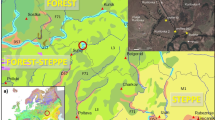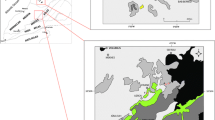Abstract
Pollen and plant macrofossil records from the Sukharysh cave located in the southern forest-steppe zone of the Southern Trans-Urals provide material for reconstruction of palaeoenvironments. The obtained results reveal that within this territory in the Early Holocene before the Atlantic there was a forest-steppe zone with forbs and Artemisia communities and birch woodland stands. Anthropogenic influence on vegetation was insignificant at that time. In the Late Subatlantic, ruderal communities, cultivated land and pastures were widely spread across the forest-steppe landscapes. Active development of agriculture by the Southern Trans-Urals population started after the Russians had occupied this territory in the 17–18th centuries a.d.








Similar content being viewed by others
References
Behre K-E (1981) Anthropogenic indicators in pollen diagrams. Pollen Spores 23:225–245
Botalov SG (2000) Pozdnyaya drevnost’ i srednevekov’e [The Late Antiquity and Middle Ages]. In: Ivanova NO (ed) Drevnyaya istotiya Yuzhnogo Zaural’ya [Ancient History of the Southern Trans-Urals. Vol. II. Early Iron Age and the Middle Ages]. South-Urals University Press, Chelyabinsk, pp 207–430 (in Russian)
Coles GM, Gilbertson DD, Hunt CO, Jenkinson RDS (1989) Taphonomy and the palynology of cave deposits. Cave Sci 16:83–88
Dobrokhotov VN (1961) Semena sornyh rastenii [Seed of weeds]. Selhozizdat, Moskow (in Russian)
Faegri K, Iversen J (1989) Textbook of pollen analysis. Blackburn Press, London
Fernández S, Fuentes N, Carrión JS, González-Sampériz P, Montoya E, Gil G, Vega-Toscano G, Riquelme JA (2007) The Holocene and Upper Pleistocene pollen sequence of Carihuela Cave, southern Spain. Geobios 40:75–90
Gaillard M-J (2007) Archaeological applications. In: Elias SA (ed) Encyclopedia of quaternary science. Elsevier, Amsterdam, pp 2,570–2,595
Gorchakovsky PL (1968) Rasteniya evropeiskikh shirokolistvennykh lesov na vostochnom predele ich areala [The European broad-leaved forest plants at their eastern distribution limits]. Academy of Science USSR, Sverdlovsk (in Russian)
Gorchakovsky PL (1975) Rastitel’nyi mir vysokogornogo Urala [Alpine flora of the Urals]. Nauka, Moscow (in Russian)
Grimm EC (1987) CONISS: a FORTRAN 77 program for stratigraphically constrained cluster analysis by the methods of incremental sum of squares. Comput Geosci 13:13–15
Grimm EC (1991) TILIA and TILIAGRAPH. Illinois State Museum, Springfield
Kalis AJ, Merkt J, Wunderlich J (2003) Environmental changes during the Holocene climatic optimum in central Europe—human impact and natural causes. Quat Sci Rev 20:33–79
Khomutova VI (1978) Sporovo-pylcevoy analiz donnykh otlozheny [Pollen analysis of bottom sediments]. In: Pazarov GV (ed) Landshaftny factor v formirovanii gidrologii ozer Yuzhnogo Urala. Nauka, Leningrad, pp 222–225 (in Russian)
Khomutova VI, Andreeva MA, Davydova NN et al (1995) Southern Ural. Lake Uvildy. In: Davydova NN (ed) The history of lakes of Northern Asia. Nauka, St.-Peterburg (in Russian)
Kolesnikova TD (1957) Chetvertichnye flory Bachkirii [Quaternary flora of Bashkortostan]. Bot J 42:878–889 (in Russian)
Komar IV, Chikishev AG (eds) (1968) Ural I Priural’e [Ural and pre-Urals]. Nauka, Moscow (in Russian)
Krasheninnikov IM (1937) Analis reliktovoy flory Yuzhnogo Urala v svyazi s istoriei rastitel’nosti i paleogeografiei Pleistocena [Analysis of the Southern Urals relict flora in connection with the Pleistocene vegetation history and paleogeography]. Sovetskaya botanica 4:16–45 (in Russian)
Krasheninnikov IM (1939) Osnovnye pyti razvitiya rastitel’nosti Yuzhnogo Urala v svyazi s paleogeografiey Severnoy Evrazii v Pleistocene i Gilotsene [The main ways of vegetation development of the Southern Urals in relation to the paleogeography of Northern Eurasia during the Pleistocene and Holocene]. Sovetskaya botanica 6-7:18–26 (in Russian)
Krivonogov SK (1988) Stratigrafiya i paleogeografiya Nizhnego Priirtyshya v epohu poslednego oledeneniya [Stratigraphy and palaeogeography of the Lower Irtysh in the era of the last glaciation]. Nauka, Novosibirsk (in Russian)
Krivonogov SK, Orlova LA, Panychev VA (1985) Semennye flory i absolutnyi vozrast opornogo razreza I nadpoimennoi terrasy Srednego Irtysha [Seminal flora and absolute age of the reference section I first terrace of the Middle Irtysh] In: Volkova VS (ed) Palinostratigrafiya Mesozoic and Cenozoic of Siberia. Nauka, Novosibirsk, pp 99–115 (in Russian)
Kulikov PV (2005) Konspekt flory Chelyabinskoy oblasti (cocudistye rasteniya) [Conspectus florae provinciae Czeljabiskiensis (plantae vasculares)] Geotur, Yekaterinburg-Miass (in Russian)
Kuprianova LA (1965) The palynology of the Amentiferae. Nauka, Moscow-Leningrad (in Russian)
Kuprianova LA, Alyoshina LA (1972) Pollen and spores of plants from the flora of European part of the USSR. Nauka, Leningrad (in Russian)
Kuzmina EA (2009) Late Pleistocene and Holocene small mammal faunas from the South Trans-Urals. Quat Int 201:25–30
Matyushin GN (1976) Mezolit Yuzhnogo Urala [The Metholitic of the Southern Urals]. Nauka, Moscow (in Russian)
Matyushin GN (1982) Eneolit Yuzhnogo Urala [The Chalcolithic of the Southern Urals]. Nauka, Moscow (in Russian)
Milkov FN, Berezhnoy AV, Mikhno VB (1993) Terminologicheski slovar’ po fizicheskoi geografii [Terminological dictionary of physical geography] Vysshaya shkola, Moscow (in Russian)
Mosin VS (2000) Kamennyi vek [The Stone Age]. In: Ivanova NO (ed) Drevnyaya istotiya Yuzhnogo Zaural’ya [Ancient History of the Southern Trans-Urals.Vol. I. The Stone Age. The Bronze Age. South-Ural University Press, Chelyabinsk, pp 21–240 (in Russian)
Naumenko NI (2008) Flora i rastitel’nost’ Yuzhnogo Zaural’ya [On the flora and vegetative cover of the Southern Trans-Urals]. Kurgan University Press, Kurgan (in Russian)
Navarro Camacho C, Carrion JS, Navarro J, Munuera M, Prieto AR (2000) An experimental approach to the palynology of cave deposits. J Quat Sci 15:603–619
Nikitin PA (1957) Pliocenovye i chetvertichnye flory Voronezhskoi oblasti [Pliocene and Quaternary flora of the Voronezh region]. Academy of Science of USSR, Moscow-Leningrad (in Russian)
Nikitin VP (1969) Paleokarpologicheskyi metod [Plant macrofossil analysis]. Tomsk University Press, Tomsk (in Russian)
Nikitin VV (1983) Sornye rasteniya flory SSSR [Weeds of the USSR flora]. Nauka, Leningrad (in Russian)
NJa Katz, Katz SV (1978) O smenax rastitel’nosti na vostochnykh predgor’yakh Yuzhnogo Urala v poslelednikovoe vremya [On the changes of vegetation in the eastern foothills of the Southern Urals during the Poastglacial period]. Bull Moscow Soc Nat Biol Ser 83:97–106 (in Russian)
NJa Katz, Katz SV, Kipiani MG (1965) Atlas i opredelitel’ plodov i semyan, vstrechayushchihsya v chetvertichnyh otlozheniyah SSSR [Atlas and the identification keys of the fruits and seeds occurring in the Quaternary deposits of the USSR]. Nauka, Moscow (in Russian)
Panova NK (1981) Formirovanie pastitel’nogo pokrova srednegornogo vysotnogo poyasa Yuzhnogo Urala s izmeneniyami klimata v golotsene [Formation of vegetative cover of the medium-altitude zone of the Southern Urals due to climate change in the Holocene]. Interconnection of environment and forest vegetation in the Urals. Sverdlovsk, pp 40–57 (in Russian)
Panova NK (1982) Istoriya gornykh lesov centralnoy chasti Yuzhnogo Urala v golocene [History of moumtain forests in the Southern Urals crntral part in Holocene]. Lesovedenie 1:26–34 (in Russian)
Panova NK (1990) Istoriya razvitiya rastitel’nosti gornoi chasti Yuzhnogo Urala v pozdnem plyeistotsene i golotsene, po palinologicheskim dannym [History of vegetation development of mountain part of the Southern Urals during the Late Pleistocene and Holocene based on pollen data]. In: Smirnov NG (ed) Istoricheslaya ekologiya zhivotnych gor Yuzhnogo Urala [History ecology of animal of the Southern Ural Mountains]. UB RAS USSR, Sverdlovsk, pp 144–158 (in Russian)
Panova NK, Makovsky BI (1987) O golocenovoy dinamike rastitel’nosti I vozraste bolot v verkhnem lesnom poyase gory Yaman-Tau [On the Holocene vegetation dynamics and the age of bogs in the upper forest belt of Yaman-Tau Mountain]. In: Zubareva RS, Smolonogov EP (eds) Vostanovitel’naya i vozrastnaya dinamica tayezhnykh lesov Srednego Urala. IPAE, Sverdlovsk, pp 95–102 (in Russian)
Poska A, Saarse L, Veski S (2004) Reflections of pre- and early-agrarian human impact in the pollen diagrams of Estonia. Palaeogeogr Palaeoclim Palaeoecol 209:37–50
Reille M (1995) Pollen et spores d’Europe et d’Afrique du nord Supplement 1. Laboratoire de botanique historigue et palynologie. URA CNRS, Marseille
Reille M (1998) Pollen et spores d’Europe et d’Afrique du nord Supplement 2. Laboratoire de botanique historigue et palynologie. URA CNRS, Marseille
Smirnov NG (ed) (1990) Istoricheslaya ekologiya zhivotnych gor Yuzhnogo Urala [History ecology of animal of the Southern Ural Mountains]. UB RAS USSR, Sverdlovsk (in Russian)
Stockmarr J (1971) Tablets with spores used in absolute pollen analysis. Pollen Spores 13:615–621
Subetto DA, Davydova NN, Sapelko TV, Heustrueva IY (2004) Paleogeografiya ozera Uvildy, Yuzhny Ural [Palaeogiography of Lake Uvildy]. In: Deryagin VV (ed) Problemy geografii Urala I sopredel’nykh territory. Proceedings of conference. Chelyabinsk Pedagogical University Press, Chelyabinsk, pp 94–96 (in Russian)
Tataurov SF (2008) The influence of Russian immigrants on the life of Siberian Tatars (based on Tarski Irtysh). Russian Culture in archaeological research. Apelsin, Omsk, pp 384–395 (in Russian)
Usoltsev VA (2001) Fitomassa lesov Severnoy Evrasii [Forest biomass of Northern Eurasia]. Ural Brunch Press of Russian Academy of Sciences, Yekaterinburg (in Russian)
van Geel B (2001) Non-pollen palynomorphs. In: Smol JP, Birks HJB, Last WM (eds) Tracking Environmental Change Using Lake Sediments. Volume 3: Terrestrial, Algal, and Siliceous Indicators. Kluwer, Dordrecht, pp 99–119
van Geel B, Buurman J, Brinkkemper O, Schelvis J, Aptroot A, Van Reenen G, Hakbijl T (2003) Environmental reconstruction of a Roman Period settlement site in Uitgeest (The Netherlands), with special reference to coprophilous fungi. J Archaeol Sci 30:873–883
Velichkevich FY, Zastawniak E (2009) Atlas of the Pleistocene vascular plant macrofossils of Central and Eastern Europe Part 2W. Szafer Institute of Botany. Polish Academy of Sciences, Krakow
Weninger B, Jöris O, Danzeglocke U (2006) http://www.calpal.de
Acknowledgments
We would like to thank VI Yurin, EA Kuzmina, NA Plasteeva and DA Yavsheva for their help in field work, N. Soboleva and S. Trofimova for assistance in the preparation of this manuscript, and PA Kosintsev for his suggestions. This study was supported by program of the Russian Academy of Science “Origin of Biosphere and Evolution of Geobiological Systems” No. 09-P-4-1001 and scientific project (No. 09-M-457-2001) of the Ural Branch of the Russian Academy of Science.
Author information
Authors and Affiliations
Corresponding author
Additional information
Communicated by E. Marinova.
Rights and permissions
About this article
Cite this article
Lapteva, E.G., Korona, O.M. Holocene vegetation changes and anthropogenic influence in the forest-steppe zone of the Southern Trans-Urals based on pollen and plant macrofossil records from the Sukharysh cave. Veget Hist Archaeobot 21, 321–336 (2012). https://doi.org/10.1007/s00334-011-0333-z
Received:
Accepted:
Published:
Issue Date:
DOI: https://doi.org/10.1007/s00334-011-0333-z




